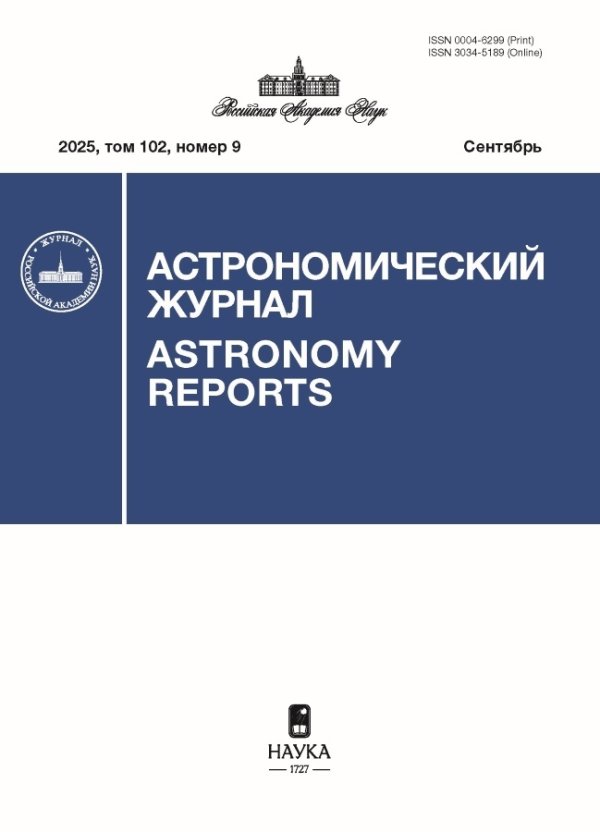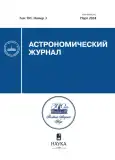Probing the ionosphere with pulses from the pulsar B2016+28 at a frequency of 324 MHz
- Authors: Burgin M.S.1, Popov M.V.1
-
Affiliations:
- P.N. Lebedev Physical Institute of the Russian Academy of Sciences
- Issue: Vol 101, No 3 (2024)
- Pages: 233-243
- Section: Articles
- URL: https://rjsvd.com/0004-6299/article/view/647611
- DOI: https://doi.org/10.31857/S0004629924030044
- EDN: https://elibrary.ru/KJTMND
- ID: 647611
Cite item
Abstract
Using ground-space VLBI data from the RadioAstron project archive, the phase distortions of the cross-spectrum caused by the ionosphere have been calculated and their influence on the results of determination of the visibility function has been studied. The Arecibo Observatory’s 300-meter antenna served as the ground station for the interferometer. The separation of ionospheric phase distortions from the influence of the interstellar and interplanetary medium and instrumental errors is based on different frequency dependencies of these effects. The amplitude of ionospheric phase variation caused by electron density fluctuations in the ionosphere above the Arecibo radio telescope is several radians per observation session of about one hour. The structure function of phase variations indicates a continuous spectrum of electron density fluctuations at typical times of 2–5 min with no pronounced signs of quasi-periodic processes. Ionospheric phase fluctuations during pulsar observations increase the width of the maximum of the amplitude of the visibility function as a function of the residual interference frequency by 5–10 mHz with a decrease in the value at the maximum of ≈ 10%. When constructing images of radio galaxies and quasars from ground-based VLBI observations, these phase shifts can significantly distort the final results.
Keywords
Full Text
About the authors
M. S. Burgin
P.N. Lebedev Physical Institute of the Russian Academy of Sciences
Email: mburgin@asc.rssi.ru
Astrospace Center
Russian Federation, MoscowM. V. Popov
P.N. Lebedev Physical Institute of the Russian Academy of Sciences
Author for correspondence.
Email: popov069@asc.rssi.ru
Astrospace Center
Russian Federation, MoscowReferences
- Н. Кардашев, В. Хартов, В. Абрамов, В. Авдеев и др., Астрон. журн. 90(3), 179 (2013).
- B. J. Rickett, Ann. Rev. Asron. Astropys. 15, 479 (1977).
- B. J. Rickett, Ann. Rev. Asron. Astropys. 28, 561 (1990).
- J. R. Jokipii, Ann. Rev. Asron. Astropys. 11, 1 (1973).
- S. K. Alurkar, Solar and Interplanetary Disturbances, Astron. and Astrophys. Series (World Scientific, 1997).
- J. Aarons, Proc. IEEE 70, 360 (1982).
- Q. Zhi-Han and Z. Yong, in Developments in astrometry and their impact on astrophysics and geodynamics, Proc. of the 156th Symp. IAU held in Shanghai, China, September 15–19, 1992; edited by I. I. Mueller and B. Kolaczek (Dordrecht: Kluwer Academic Publishers, 1993), IAU Symp. 156, 207 (1993).
- T. Hobiger, T. Kondo, and H. Schuh, Radio Science 41(1), id. RS1006 (2006).
- R. Heinkelmann, T. Hobiger, and M. Schmidt, in EGU General Assembly 2009, held 19-24 April, 2009 in Vienna, Austria; Abstracts, p. 5715; http://meetings.copernicus.org/egu2009, p. 5715 .
- V.I. Zhuravlev, Y.I. Yermolaev, and A.S. Andrianov, Monthly Not. Roy. Astron. Soc. 491, 5843 (2020).
- B. Dennison and R. S. Booth, Monthly Not. Roy. Astron. Soc. 224, 927 (1987).
- V.I. Shishov, T.V. Smirnova, C.R. Gwinn, A.S. Andrianov, M.V. Popov, A.G. Rudnitskiy, and V.A. Soglasnov, Monthly Not. Roy. Astron. Soc. 468, 3709 (2017).
- M.V. Popov, N. Bartel, M.S. Burgin, T.V. Smirnova, and V.A. Soglasnov, Monthly Not. Roy. Astron. Soc. 506, 4101 (2021).
- E.N. Fadeev, A.S. Andrianov, M.S. Burgin, M.V. Popov, A.G. Rudnitskiy, V.I. Shishov, T.V. Smirnova, and V.A. Zuga, Monthly Not. Roy. Astron. Soc. 480, 4199 (2018).
- S.F. Likhachev, V.I. Kostenko, I.A. Girin, A.S. Andrianov, A.G. Rudnitskiy, and V.E. Zharov, J. Astron. Instrument. 6(3), id. 1750004 (2017).
- M. Mevius, S. van der Tol, V.N. Pandey, H.K. Vedantham et al., Radio Science 51(7), 927 (2016).
- A.R. Thompson, J.M. Moran, and J.W. Swenson, Jr., Interferometry and Synthesis in Radio Astronomy, 3rd ed. (Springer, Cham, 2017).
- R.A. Fallows, M.M. Bisi, B. Forte, T. Ulich, A.A. Konovalenko, G. Mann, and C. Vocks, Astrophys. J. Letters 828(1), id. L7 (2016).
- A.C.S. Readhead, M.C. Kemp, and A. Hewish, Monthly Not. Roy. Astron. Soc. 185, 207 (1978).
Supplementary files















